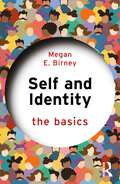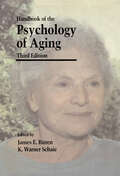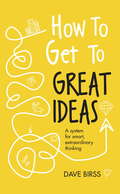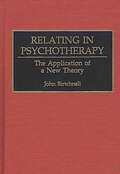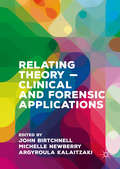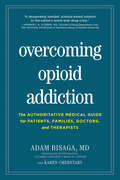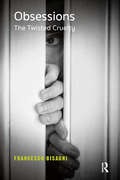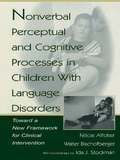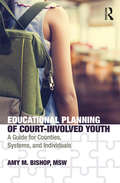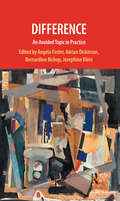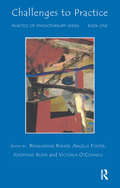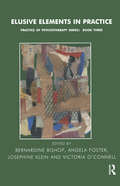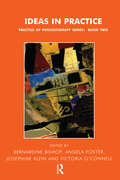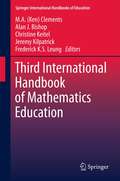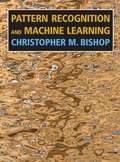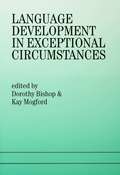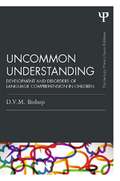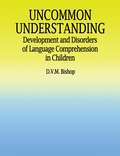- Table View
- List View
Self and Identity: The Basics (The Basics)
by Megan E. BirneySelf and Identity: The Basics is a jargon-free and accessible introduction that draws on key theories and ideas in Social Psychology to explore the ways that other people affect our thoughts, feelings, and behaviours. Highlighting selfhood as a function of identity, the book shows that it is our relationships with others in our social world that largely determine who we are. "Who am I?" It’s a question that most all humans have grappled with at some point or another. This book seeks to answer this question through relatable examples that show how psychological theory can be applied to our own lives. It considers the philosophical and psychological context in which ideas about selfhood have developed and reviews the ways that the people around us, and the groups that we belong to, affect who we are. Finally, these ideas are considered in the context of real-world phenomena and behaviours; for instance, how we use language, conflict between groups, and social influence. With a glossary of key terms, suggestions for further reading, and chapter summaries, this book is an ideal introduction for students of social psychology and related fields. It will be of interest to anyone who wants to gain social psychological insight into who they are and how others got them there.
Self and Identity: The Basics (The Basics)
by Megan E. BirneySelf and Identity: The Basics is a jargon-free and accessible introduction that draws on key theories and ideas in Social Psychology to explore the ways that other people affect our thoughts, feelings, and behaviours. Highlighting selfhood as a function of identity, the book shows that it is our relationships with others in our social world that largely determine who we are. "Who am I?" It’s a question that most all humans have grappled with at some point or another. This book seeks to answer this question through relatable examples that show how psychological theory can be applied to our own lives. It considers the philosophical and psychological context in which ideas about selfhood have developed and reviews the ways that the people around us, and the groups that we belong to, affect who we are. Finally, these ideas are considered in the context of real-world phenomena and behaviours; for instance, how we use language, conflict between groups, and social influence. With a glossary of key terms, suggestions for further reading, and chapter summaries, this book is an ideal introduction for students of social psychology and related fields. It will be of interest to anyone who wants to gain social psychological insight into who they are and how others got them there.
Handbook of the Psychology of Aging
by James E. BirrenHandbook of the Psychology of Aging, Third Edition describes the psychology of adult development and aging. This book is organized into four parts encompassing 28 chapters that cover the basic behavioral changes and capacities occurring with advancing age. The first part deals with the history, concept, and models of the psychology of aging. This part also examines the distinctions between physical, biological, psychological, and social time or age. The second part explores the influences of racial, ethnic, and cultural factors on biological/health, social, and psychological aging processes. This part also surveys gender differences in aging. The third part describes numerous behavioral processes, changes, and patterns in advancing age. This part specifically considers the motivation, cognitive and motor performance, attentional processes, learning, memory, personality, and wisdom in aging. The fourth part focuses on the applications of the concepts and principles of aging to the individual and society. This book will be of great value to psychologists, researchers, and graduate students.
How to Get to Great Ideas: A system for smart, extraordinary thinking
by Dave BirssThe highly practical lessons in How to Get to Great Ideas are based on neuroscience, psychology and sociology. Written by former advertising creative director Dave Birss, this book offers a brilliant new system for conceiving original and valuable ideas. It looks at how to frame a problem, how to push your thinking, how to sell the idea, how to build support for it and how to inspire others to have great ideas. It proves that any organization - and any individual or department within an organization - can create a fertile environment for ideas. Combining a practical research-based system with fascinating insights and inspiring and humorous writing, the book also includes the problem-solving system RIGHT Thinking. This is a tool which enables a more effective way to generate more effective ideas, and is one that anyone can use to transform themselves or their business. Training on this system is also available in person from the author. And will be released soon as an online course.
Relating in Psychotherapy: The Application of a New Theory (Human Evolution, Behavior, and Intelligence)
by John BirtchnellIn his earlier book, How Humans Relate, John Birtchnell proposed that relating occurs along two axes, a horizontal one concerning becoming close versus being distant and a vertical one concerning being upper versus being lower. He called closeness, distance, upperness, and lowerness the relating objectives, and he proposed that people need to acquire competence in attaining and maintaining these objectives. In this book, he argues that the task of psychotherapists is to identify and correct, within these axes, people's relating incompetencies, and to enable people to cope with the relating incompetencies of others. He considers this to be the case across all psychotherapies.Dr. Birtchnell proposes the existence of an unconscious, automatic, inner brain that monitors the relating objectives. He argues that the psychotherapist assists the person, through the conscious, outer brain, to correct and improve the inner brain's least effective relating strategies. He uses the term interrelating to describe the interplay between the relating of two or more people. This has application in couple, family, group, and community therapy, in which the psychotherapist's task is to enable the interrelaters to understand and correct their mutually reinforcing, destructive interactions. He introduces a set of questionnaires, from the scores of which a computer can print out an easy-to-read diagram of the direction and degree of people's relating incompetencies.
Relating Theory – Clinical and Forensic Applications
by John Birtchnell Michelle Newberry Argyroula KalaitzakiThis book brings together recent research developments in relating theory. It is divided into four parts, which introduce the reader to relating theory, how it has developed and how it can be applied to clinical and forensic psychology. Topics include how couples relate to one another, how young people relate to their parents, how assessments of relating can be used in therapy, how specific negative relating styles relate to offending behaviour, risk taking and alcohol use, psychopathic and sadistic tendencies, and how the interpersonal relating of offenders can change during treatment in prison. The book covers international research involving both quantitative and qualitative methods, and will be of interest to clinicians, academics and both undergraduate and postgraduate students in the fields of psychology, clinical psychology, forensic/criminal psychology, psychiatry, psychotherapy, counselling, art-therapy, and mental health.
Overcoming Opioid Addiction: The Authoritative Medical Guide for Patients, Families, Doctors, and Therapists
by Adam Bisaga MD Karen ChernyaevFrom a leading addiction expert, a desperately needed medical guide to understanding, treating, and finally defeating opioid use disorder Drug overdoses are now the leading cause of death for Americans under the age of 50, claiming more lives than the AIDs epidemic did at its peak. Opioid abuse accounts for two-thirds of these overdoses, with over 100 Americans dying from opioid overdoses every day. Now Overcoming Opioid Addiction provides a comprehensive medical guide for opioid use disorder (OUD) sufferers, their loved ones, clinicians, and other professionals. Here is expertly presented, urgently needed information and guidance, including: Why treating OUD is unlike treating any other form of drug dependencyThe science that underlies addiction to opioids, and a clear analysis of why this epidemic has become so deadlyThe different stages and effective methods of treatment, including detoxification vs. maintenance medications, as well as behavioral therapiesHow to deal with relapses and how to thrive despite OUDPlus a chapter tailored to families with crucial, potentially life-saving information, such as how to select the best treatment program, manage medications, and reverse an overdose.
Obsessions: The Twisted Cruelty
by Francesco BisagniThis book explores the interrelatedness between obsessive compulsive disorders, thinking disorders, and depression. The issue is considered both from a psychiatric viewpoint and from a psychodynamic perspective. The age of the cases presented in the book ranges from childhood through adolescence to adulthood. Obsessions: The Twisted Cruelty is a challenging contribution to contemporary clinical debate, especially regarding the role of analytically-oriented psychotherapy in the treatment of OCD, and how to deal with the psychiatric treatment and combine the two approaches, while keeping the focus on the transference-countertransference interplay. After the first theoretical chapter, the relationship between obsessions and thinking impairments is discussed, with specific reference to delusional ideation. A section entitled "the anal conundrum" follows. Encopresis and anal masturbation during childhood are discussed, as well as the identification of the child with a maternal "faecal object. The last section explores the connection with depression, and some specific features of sadism.
Obsessions: The Twisted Cruelty
by Francesco BisagniThis book explores the interrelatedness between obsessive compulsive disorders, thinking disorders, and depression. The issue is considered both from a psychiatric viewpoint and from a psychodynamic perspective. The age of the cases presented in the book ranges from childhood through adolescence to adulthood. Obsessions: The Twisted Cruelty is a challenging contribution to contemporary clinical debate, especially regarding the role of analytically-oriented psychotherapy in the treatment of OCD, and how to deal with the psychiatric treatment and combine the two approaches, while keeping the focus on the transference-countertransference interplay. After the first theoretical chapter, the relationship between obsessions and thinking impairments is discussed, with specific reference to delusional ideation. A section entitled "the anal conundrum" follows. Encopresis and anal masturbation during childhood are discussed, as well as the identification of the child with a maternal "faecal object. The last section explores the connection with depression, and some specific features of sadism.
Nonverbal Perceptual and Cognitive Processes in Children With Language Disorders: Toward A New Framework for Clinical intervention
by Walter Bischofberger F‚licie AffolterA growing body of literature is suggesting that many children with language disorders and delays--even those with so-called specific language impairment--have difficulties in other domains as well. In this pathbreaking book, the authors draw on more than 40 years of research and clinical observations of populations ranging from various groups of children to adults with brain damage to construct a comprehensive model for the development of the interrelated skills involved in language performance, and trace the crucial implications of this model for intervention. Early tactual feedback, they argue, is more critical for the perceptual/cognitive organization of experiences that constitutes a foundation for language development than either visual or auditory input, and the importance of tactually-anchored nonverbal interaction cannot be ignored if efforts at treatment are to be successful. All those professionally involved in work with children and adults with language problems will find the authors' model provocative and useful.
Nonverbal Perceptual and Cognitive Processes in Children With Language Disorders: Toward A New Framework for Clinical intervention
by Walter Bischofberger F‚licie AffolterA growing body of literature is suggesting that many children with language disorders and delays--even those with so-called specific language impairment--have difficulties in other domains as well. In this pathbreaking book, the authors draw on more than 40 years of research and clinical observations of populations ranging from various groups of children to adults with brain damage to construct a comprehensive model for the development of the interrelated skills involved in language performance, and trace the crucial implications of this model for intervention. Early tactual feedback, they argue, is more critical for the perceptual/cognitive organization of experiences that constitutes a foundation for language development than either visual or auditory input, and the importance of tactually-anchored nonverbal interaction cannot be ignored if efforts at treatment are to be successful. All those professionally involved in work with children and adults with language problems will find the authors' model provocative and useful.
Educational Planning of Court-Involved Youth: A Guide for Counties, Systems, and Individuals
by Amy BishopEducational Planning of Court-Involved Youth provides a framework for alleviating chronic barriers for youth in the child welfare and juvenile justice systems. This guide combines best-practice recommendations from national research with direct service tactics employed successfully in multiple counties. Included are the necessary components to implement a collaborative, community-centered intervention system that meets the needs of the county, family, and individual. With the understanding that each county carries its own strengths, barriers, and resources, these tools serve as a model for assessing and adapting the system to cater to the unique needs of each area in which it is implemented. This text helps facilitate the coordination and collaboration necessary to foster comprehensive systems and individualized planning for youth.
Educational Planning of Court-Involved Youth: A Guide for Counties, Systems, and Individuals
by Amy BishopEducational Planning of Court-Involved Youth provides a framework for alleviating chronic barriers for youth in the child welfare and juvenile justice systems. This guide combines best-practice recommendations from national research with direct service tactics employed successfully in multiple counties. Included are the necessary components to implement a collaborative, community-centered intervention system that meets the needs of the county, family, and individual. With the understanding that each county carries its own strengths, barriers, and resources, these tools serve as a model for assessing and adapting the system to cater to the unique needs of each area in which it is implemented. This text helps facilitate the coordination and collaboration necessary to foster comprehensive systems and individualized planning for youth.
Difference: An Avoided Topic in Practice
by Bernardine BishopDifference is a complex and often disturbing issue. The purpose of this book is to encourage a culture of open enquiry into an emotionally charged subject which, the editors argue, has been largely avoided by the profession. Theoretically psychoanalysis is all about recognition and appreciation of difference, yet the psychoanalytic profession itself does not have a good reputation in this area. This is a courageous collection of papers. All contributors have been prepared to go into print about situations in which difference is a significant element in their work and one around which they have felt uneasy and uncertain as they have found themselves in uncharted territory. Through painstaking analysis of their experience and that of their patients and clients, each contributor provides the reader with some useful insights and guidelines for future reference as well as some clear and stimulating illustrations of effective thinking in strange and disturbing situations. What makes this thinking effective is the demonstrated ability of all contributors to preserve their analytic functioning whatever the circumstances.
Difference: An Avoided Topic in Practice (The\lcp Practice In Psychotherapy Ser.)
by Bernardine BishopDifference is a complex and often disturbing issue. The purpose of this book is to encourage a culture of open enquiry into an emotionally charged subject which, the editors argue, has been largely avoided by the profession. Theoretically psychoanalysis is all about recognition and appreciation of difference, yet the psychoanalytic profession itself does not have a good reputation in this area. This is a courageous collection of papers. All contributors have been prepared to go into print about situations in which difference is a significant element in their work and one around which they have felt uneasy and uncertain as they have found themselves in uncharted territory. Through painstaking analysis of their experience and that of their patients and clients, each contributor provides the reader with some useful insights and guidelines for future reference as well as some clear and stimulating illustrations of effective thinking in strange and disturbing situations. What makes this thinking effective is the demonstrated ability of all contributors to preserve their analytic functioning whatever the circumstances.
Challenges to Practice (The\lcp Practice In Psychotherapy Ser.)
by Bernardine Bishop Angela Foster Josephine Klein Victoria O’ConnellThe first title in the Practice of Psychotherapy Series that explores the limits of psychoanalytic psychotherapy. Each of the five chapters in this book takes up an aspect of this challenge. In an open and enquiring manner, the authors invite readers to share in their thinking as they describe how they use their psychoanalytic skills to understand the nature of particular challenges. The Practice of Psychotherapy Series is intended to address a wide variety of important and challenging issues confronting those working in diverse contexts as psychoanalytic psychotherapists. Written by members of the respected London Centre for Psychotherapy, this volume offers an honest and stimulating first contribution.
Elusive Elements in Practice (The\lcp Practice In Psychotherapy Ser.)
by Bernardine Bishop Angela Foster Josephine Klein Victoria O'ConnellThe third volume in the The Practice of Psychotherapy series, Elusive Elements in Practice brings together a collection of papers, examining their ideas and theories more commonly regarded as off-centre, or indeed elusive, in psychoanalytic psychotherapy. The papers in this volume concentrate on the religious and spiritual dimension of the therapeutic encounter, the "aesthetic experience", creativity and mysticism. These "moments of relatedness", or meetings of minds, are discussed and examined with the help of clinical examples.'...psychotherapists tend to agree on what is just too eccentric and is to be regarded with reserve and suspicion. These ideas are left on the margins and, getting less attention, they are more elusive. They will not get concentrated consideration either in the consulting room or in the study. This is one reason why they are more elusive.
Ideas in Practice (The\lcp Practice In Psychotherapy Ser. #Vol. 2)
by Bernardine Bishop Angela Foster Josephine Klein Victoria O’ConnellComprising the second volume in the series The Practice of Psychotherapy, this volume brings together six contributors, all members of the London Centre for Psychotherapy, presenting psychoanalytic ideas lucidly illustrated by clinical observatioins taken from the consulting room. Focusing upon such issues as sibling attachment and the impact of maternal absence, this collection of essays offers uniquely personal insights and new idrom psychotherapeutic encounters. The author believes that in each of these papers there is the spark of an original idea...grounded indeed in psychoanalytic theory, but influenced by individual experience and observation in the consulting room.
Third International Handbook of Mathematics Education (Springer International Handbooks of Education #27)
by Christine Keitel, Jeremy Kilpatrick And Frederic Alan J. Bishop, Christine Keitel BishopThe four sections in this Third International Handbook are concerned with: (a) social, political and cultural dimensions in mathematics education; (b) mathematics education as a field of study; (c) technology in the mathematics curriculum; and (d) international perspectives on mathematics education. These themes are taken up by 84 internationally-recognized scholars, based in 26 different nations. Each of section is structured on the basis of past, present and future aspects. The first chapter in a section provides historical perspectives (“How did we get to where we are now?”); the middle chapters in a section analyze present-day key issues and themes (“Where are we now, and what recent events have been especially significant?”); and the final chapter in a section reflects on policy matters (“Where are we going, and what should we do?”). Readership: Teachers, mathematics educators, ed.policy makers, mathematicians, graduate students, undergraduate students. Large set of authoritative, international authors.
Pattern Recognition and Machine Learning (Information Science And Statistics Ser.)
by Christopher BishopThis is the first textbook on pattern recognition to present the Bayesian viewpoint. The book presents approximate inference algorithms that permit fast approximate answers in situations where exact answers are not feasible. It uses graphical models to describe probability distributions when no other books apply graphical models to machine learning. No previous knowledge of pattern recognition or machine learning concepts is assumed. Familiarity with multivariate calculus and basic linear algebra is required, and some experience in the use of probabilities would be helpful though not essential as the book includes a self-contained introduction to basic probability theory.
Language Development In Exceptional Circumstances
by Dorothy Bishop K. MogfordEver since attempts were made to describe and explain normal language development, references to exceptional circumstances have been made. Variations in the conditions under which language is acquired can be regarded as natural experiments, which would not be feasible or ethical under normal circumstances. This can throw light on such questions as: *What language input is necessary for the child to learn language? *What is the relationship between cognition and language? *How independent are different components of language function? *Are there critical periods for language development? *Can we specify necessary and sufficient conditions for language impairment? This book covers a range of exceptional circumstances including: extreme deprivation, twinship, visual and auditory impairments, autism and focal brain damage? Written in a jargon-free style, and including a glossary of linguistic and medical terminology, the book assumes little specialist knowledge. This text is suitable for both students and practitioners in the fields of psycholinguistics, developmental and educational psychology, speech pathology, paediatrics and special education.
Language Development In Exceptional Circumstances
by Dorothy Bishop Kay MogfordEver since attempts were made to describe and explain normal language development, references to exceptional circumstances have been made. Variations in the conditions under which language is acquired can be regarded as natural experiments, which would not be feasible or ethical under normal circumstances. This can throw light on such questions as: *What language input is necessary for the child to learn language? *What is the relationship between cognition and language? *How independent are different components of language function? *Are there critical periods for language development? *Can we specify necessary and sufficient conditions for language impairment? This book covers a range of exceptional circumstances including: extreme deprivation, twinship, visual and auditory impairments, autism and focal brain damage? Written in a jargon-free style, and including a glossary of linguistic and medical terminology, the book assumes little specialist knowledge. This text is suitable for both students and practitioners in the fields of psycholinguistics, developmental and educational psychology, speech pathology, paediatrics and special education.
Uncommon Understanding: Development and disorders of language comprehension in children (Psychology Press & Routledge Classic Editions)
by Dorothy V. BishopThis is a Classic Edition of Dorothy Bishop's award-winning textbook on the development of language comprehension, which has been in print since 1997, and now includes a new introduction from the author. The book won the British Psychological Society book award in 1999, and is now widely seen as a classic in the field of developmental language disorders. Uncommon Understanding provides a comprehensive account of the process of comprehension, from the reception of an acoustic signal, to the interpretation of communicative intentions, and integrates a vast field of research on language acquisition, psycholinguistics and neuropsychology. In the new introduction Dorothy Bishop reflects on the organization of the book, and developments in the field since the book was first published. A major theme in the book is that comprehension should not be viewed as a unitary skill – to understand spoken language one needs the ability to classify incoming speech sounds, to relate them to a "mental lexicon," to interpret the propositions encoded by word order and grammatical inflections, and to use information from the environmental and social context to grasp an intended meaning. Another important theme is that although neuropsychological and experimental research on adult comprehension provides useful concepts and methods for assessing comprehension, it should be applied with caution, because a sequential, bottom-up information processing model of comprehension is ill-suited to the developmental context. Although the main focus of the book is on research and theory, rather than practical matters of assessment and intervention, the theoretical framework presented in the book will continue to help clinicians develop a clearer understanding of what comprehension involves, and how different types of difficulty may be pin-pointed.
Uncommon Understanding: Development and disorders of language comprehension in children (Psychology Press & Routledge Classic Editions)
by Dorothy V. BishopThis is a Classic Edition of Dorothy Bishop's award-winning textbook on the development of language comprehension, which has been in print since 1997, and now includes a new introduction from the author. The book won the British Psychological Society book award in 1999, and is now widely seen as a classic in the field of developmental language disorders. Uncommon Understanding provides a comprehensive account of the process of comprehension, from the reception of an acoustic signal, to the interpretation of communicative intentions, and integrates a vast field of research on language acquisition, psycholinguistics and neuropsychology. In the new introduction Dorothy Bishop reflects on the organization of the book, and developments in the field since the book was first published. A major theme in the book is that comprehension should not be viewed as a unitary skill – to understand spoken language one needs the ability to classify incoming speech sounds, to relate them to a "mental lexicon," to interpret the propositions encoded by word order and grammatical inflections, and to use information from the environmental and social context to grasp an intended meaning. Another important theme is that although neuropsychological and experimental research on adult comprehension provides useful concepts and methods for assessing comprehension, it should be applied with caution, because a sequential, bottom-up information processing model of comprehension is ill-suited to the developmental context. Although the main focus of the book is on research and theory, rather than practical matters of assessment and intervention, the theoretical framework presented in the book will continue to help clinicians develop a clearer understanding of what comprehension involves, and how different types of difficulty may be pin-pointed.
Uncommon Understanding: Development and Disorders of Language Comprehension in Children
by Dorothy V.M. BishopA great deal has been written on how children learn to speak, but development of language comprehension has been a relatively neglected topic. This book is unique in integrating research in language acquisition, psycholinguistics and neuropsychology to give a comprehensive picture of the process we call "comprehension", right from the reception of an acoustic stimulus at the ear, up to the point where we interpret the message the speaker intended to convey by the utterance. A major theme of the book is that "comprehension" is not a unitary skill: to understand spoken language, one needs the ability to classify incoming speech sounds, to relate them to a "mental lexicon", to interpret the propositions encoded by word order and grammatical inflections, and to use information from the environmental and social context to select, from a wide range of possible interpretations, the one that was intended by the speaker. Furthermore, although neuropsychological and experimental research on adult comprehension can provide useful concepts and methods for assessing comprehension, they should be applied with caution, because a sequential, bottom-up information processing model of comprehension is ill-suited to the developmental context.The emphasis of the book is on children with specific language impairments, but normal development is also given extensive coverage. The focus is on research and theory, rather than practical matters of assessment and intervention. Nevertheless, while this book is not intended as a clinical guide to assessment, it does aim to provide a theoretical framework that can help clinicians develop a clearer understanding of what comprehension involves, and how different types of difficulty may be pinpointed.
